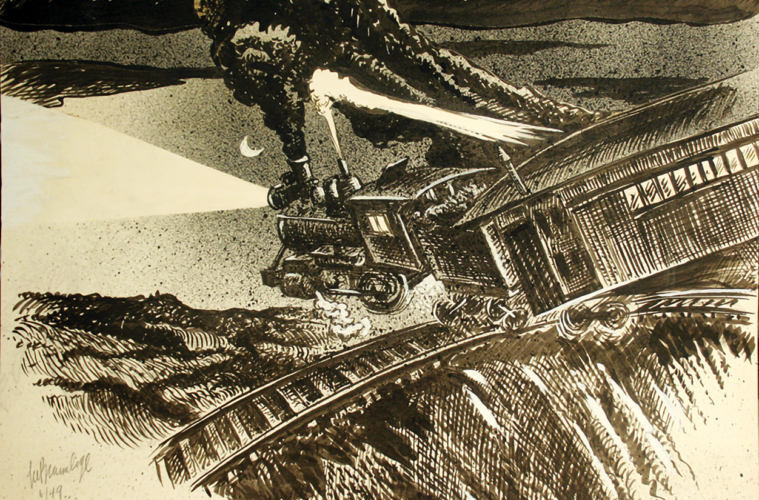The Picker Art Gallery offers a retrospective of this central New York artist’s work.
Stepping into the Picker Art Gallery, visitors are greeted by a diverse collection of artworks — ones that tell tales both ghastly and grand, spanning from horror illustrations to evocative landscapes. The exhibition, Tales of Terra: A Lee Brown Coye Retrospective, offers an immersive look into the mind and works of central New York artist Lee Brown Coye (1907–81).
Coye, born in Syracuse and having familial roots in central New York, was renowned for his eerie illustrations in the pages of horror anthologies and pulp magazines like Weird Tales. Over the course of his career, Coye’s illustrations even graced the covers of works by such legendary horror writers as H.P. Lovecraft and Ray Bradbury. Tales of Terra not only explores Coye’s influence on the world of horror art but also the influence that the places Coye called home had on his art. “One of the reasons we are doing this show is because of Lee Brown Coye’s importance to the Hamilton community,” explains Kali Steinberg, curatorial assistant of the Picker Art Gallery.
One section of the exhibition focuses on Coye’s relocation from Syracuse to Hamilton in 1959. It was in Hamilton that Coye built his own art studio, where he collaborated with other local artists for the remainder of his career. One of the most fruitful of these collaborations was with Colgate Professor of Fine Art Alfred Krakusin, with whom Coye worked for many years to create a series of bronze, copper, and aluminum panels replicating sculpted reliefs found on ancient Egyptian monuments. During the process, Colgate students had the opportunity to work under Coye and Krakusin. These sculpted panels were but one example of Coye’s artistic prowess outside the medium of illustration. “While Coye is best known for his influential illustrations for horror stories and pulp magazines, he also produced many drawings, paintings, sculptures, murals, and metalworks of both horror and other subjects,” explains Steinberg.
These lesser-known works were often inspired by local folklore, legends, literature, architecture, and history. After Coye’s death, his sister Helen, and later his son, Bob Coye ’54, donated a substantial collection of his works to the Picker, making it home to the largest collection of Coye artistry in the world. The works on display for Tales of Terra are only about 10% of Colgate’s total collection of Coye’s work.
Visitors who attended the exhibition’s opening reception on Sept. 21 had the opportunity to hear Coye’s grandson Rob share his memories of visiting the Hamilton art studio as a child. One of Rob’s fondest memories was of playing with the many pet rabbits that Coye kept loose in his studio.
This was the second Lee Brown Coye retrospective that the Picker Art Gallery has hosted, the first taking place in 1968. This current retrospective demonstrates the timeless appeal of Coye’s works and his indelible mark on the artistic world of central New York.
Tales of Terra is on exhibit until March 3, 2024.

